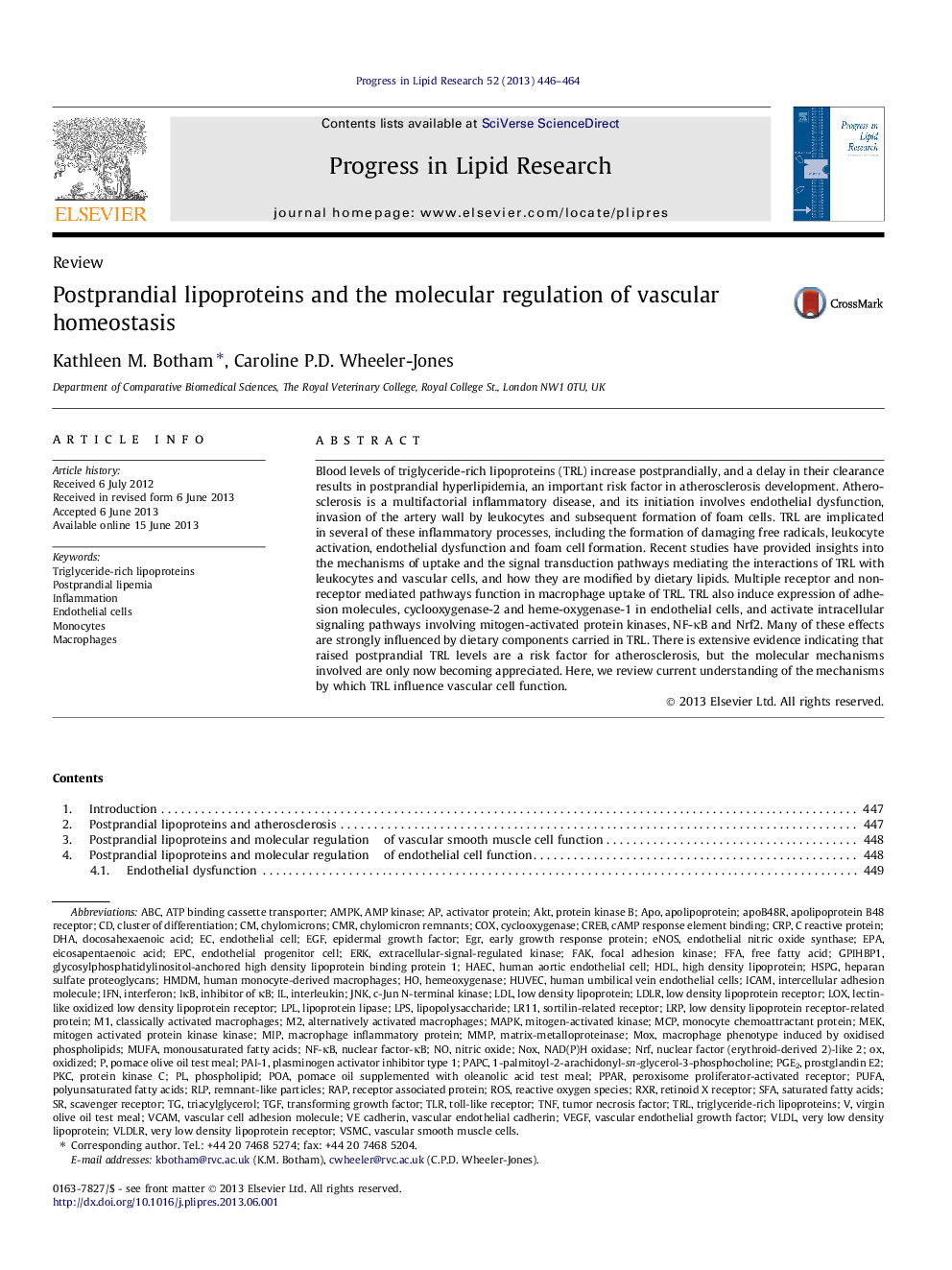| Article ID | Journal | Published Year | Pages | File Type |
|---|---|---|---|---|
| 10842902 | Progress in Lipid Research | 2013 | 19 Pages |
Abstract
Blood levels of triglyceride-rich lipoproteins (TRL) increase postprandially, and a delay in their clearance results in postprandial hyperlipidemia, an important risk factor in atherosclerosis development. Atherosclerosis is a multifactorial inflammatory disease, and its initiation involves endothelial dysfunction, invasion of the artery wall by leukocytes and subsequent formation of foam cells. TRL are implicated in several of these inflammatory processes, including the formation of damaging free radicals, leukocyte activation, endothelial dysfunction and foam cell formation. Recent studies have provided insights into the mechanisms of uptake and the signal transduction pathways mediating the interactions of TRL with leukocytes and vascular cells, and how they are modified by dietary lipids. Multiple receptor and non-receptor mediated pathways function in macrophage uptake of TRL. TRL also induce expression of adhesion molecules, cyclooxygenase-2 and heme-oxygenase-1 in endothelial cells, and activate intracellular signaling pathways involving mitogen-activated protein kinases, NF-κB and Nrf2. Many of these effects are strongly influenced by dietary components carried in TRL. There is extensive evidence indicating that raised postprandial TRL levels are a risk factor for atherosclerosis, but the molecular mechanisms involved are only now becoming appreciated. Here, we review current understanding of the mechanisms by which TRL influence vascular cell function.
Keywords
ABCAMPKCREBEPANF-κBMMPEGFLPSCOXJnkMCPRAPEPCEGRMIPPOACMRLRPHDLFFAFAKERKNRFHUVECPGE2LDLRMUFASFAPPAReNOSIκBTLRPKCTGFRetinoid X receptorVSMCPAI-1ICAMVCAMLPLHSPGVLDLRXRTRLGPIHBP1LR11HMDMAMP kinaseRLPTNFATP binding cassette transporterc-Jun N-terminal kinaseMAPKMitogen activated protein kinase kinaseNAD(P)H oxidaseNOxPAPcROSVLDLRcyclooxygenaseapoapolipoproteinAktEicosapentaenoic aciddocosahexaenoic acidFree fatty acidPolyunsaturated fatty acidsPUFAsaturated fatty acidsinflammationcAMP response element binding OxidizedLOXHAECinterferonIFNinterleukinchylomicron remnantsMOXtransforming growth factortriacylglycerolToll-like receptorcluster of differentiationDHARemnant-like particleshuman aortic endothelial cellEndothelial cellHuman umbilical vein endothelial cellsVascular smooth muscle cellsEndothelial progenitor cellEndothelial cellsendothelial nitric oxide synthaseepidermal growth factorVascular endothelial growth factorVascular Endothelial Growth Factor (VEGF)tumor necrosis factornuclear factor (erythroid-derived 2)-like 2nuclear factor-κBPhospholipidPostprandial lipemiaLipoprotein lipasehigh density lipoproteintriglyceride-rich lipoproteinsvery low density lipoproteinlow density lipoproteinLDLlipopolysaccharidematrix-metalloproteinaseMacrophageshuman monocyte-derived macrophagesAlternatively activated macrophagesClassically activated macrophagesMEKinhibitor of κBintercellular adhesion moleculevascular cell adhesion moleculeMonocytesPlasminogen activator inhibitor type 1Nitric oxidehemeoxygenasemacrophage inflammatory proteinmonocyte chemoattractant proteinactivator proteinreceptor associated proteinlow density lipoprotein receptor-related proteinC reactive proteinCRPearly growth response proteinprotein kinase BProtein kinase Cheparan sulfate proteoglycanschylomicronsvascular endothelial cadherinextracellular-signal-regulated kinasemitogen-activated kinasefocal adhesion kinaseReactive oxygen speciesperoxisome proliferator-activated receptorVery low density lipoprotein receptorlow density lipoprotein receptorScavenger receptorsortilin-related receptor
Related Topics
Life Sciences
Agricultural and Biological Sciences
Food Science
Authors
Kathleen M. Botham, Caroline P.D. Wheeler-Jones,
